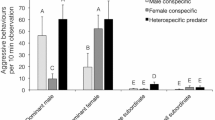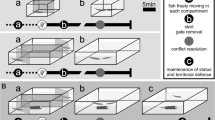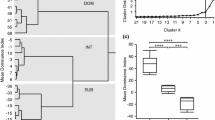Abstract
Anemonefishes (genus Amphiprion) are well known as protandrous sex-changing fish. They live symbiotically with sea anemones and form a social unit that consists of a breeding pair and several sexually immature individuals with ambisexual gonads. In general, the hierarchy of the social rank is strictly maintained in a group, and this hierarchy is considered to be one of the critical factors that induce sex change or sex differentiation in anemonefishes. Field observations have shown that behavioural characteristics of anemonefishes vary depending on the environment. In this study we examined the differences in territorial aggression directed at conspecific intruders according to sexual status in the false clown anemonefish, Amphiprion ocellaris, under laboratory conditions. Resident–intruder tests were conducted on groups consisting of three anemonefish: a dominant female, a second-ranked male and a subordinate ambisexual individual. Females and males showed more aggressive behaviour than did ambisexual individuals, and behaviours were specifically directed at intruders of the same sexual status, not at those of the opposite sex. Notably, the female residents displayed fierce aggressive behaviours particularly toward female intruders, whereas male residents engaged more often in side-by-side swimming with male intruders than with female or ambisexual intruders. Ambisexual intruders were threatened by all residents, rarely attacked. We observed only few aggressive acts towards tank mates. These results suggest that sexually mature resident anemonefish in a confined space, such as under laboratory conditions, perceive intruders of the same sexual status as competitors for reproductive status and thus, dominant social rank.



Similar content being viewed by others
References
Adkins-Regan E (2011) Neuroendocrine contributions to sexual partner preference in birds. Front Neuroendocrinol 32:155–163
Bruslea-Sicard S, Reinboth R, Fourcault B (1994) Germinal potentialities during sexal state changes in a protandric hermaphrodite, Amphiprion frenatus (Teleostei, Pomacentridae). J Fish Biol 45:597–611
Buston PM (2003) Social hierarchies: size and growth modification in clownfish. Nature 424:145–146
Carvalho TB, Gonçalves-de-Freitas E (2008) Sex group composition, social interaction, and metabolism in the fish Nile tilapia. Braz J Bio 68:807–812
Cole HW, Figler MH, Parente FJ, Harman VS (1980) The relationship between sex and aggression in convict cichlids (Cichlasoma nigrofasciatum). Behaviour 75:1–21
Desjardins JK, Stiver KA, Fitzpatrick JL, Balshine S (2008) Differential responses to territory intrusions in cooperatively breeding fish. Anim Behav 75:595–604
Edenbrow M, Croft DP (2012) Kin and familiarity influence association preferences and aggression in the mangrove killifish Kryptolebias marmoratus. J Fish Biol 80:503–518
Ferguson JN, Young LJ, Insel TR (2002) The neuroendocrine basis of social recognition. Front Neuroendocrinol 23:200–224
Francis RC (1990) Temperament in a fish: a longitudinal study of the development of individual differences in aggression and social rank in the Midas cichlid. Ethology 86:311–325
Fricke HW (1974) Öko-Ethologie des monogamen Anemonenfisches Amphiprion bicinctus (Freiwasseruntersuchung aus dem Roten Meer). Z Tierpsychol 36:429–512
Fricke HW (1979) Mating system, resource defense and sex change in the anemonefish Amphiprion akallopisos. Z Tierpsychol 50:313–326
Fricke HW, Fricke S (1977) Monogamy and sex change by aggressive dominance in coral reef fish. Nature 266:830–832
Godwin J (1994) Behavioural aspects of protandrous sex change in the anemonefish, Amphiprion melanopus, and endocrine correlates. Anim Behav 48:551–567
Goldstein R (1989) Breeding marine clownfish. Aquarium Fish Mag 1:32
Hattori A (1991) Socially controlled growth and size-dependent sex change in the anemonefish Amphiprion frenatus in Okinawa, Japan. Jpn J Ichthyol 38:165–177
Heg D, Bender N, Hamilton (2004) Strategic growth decisions in helper cichlids. Proc R Soc B 271:s505–s508
Iwata E, Nagai Y, Hyoudou M, Sasaki H (2008) Social environment and sex differentiation in false clown anemonefish, Amphiprion ocellaris. Zool Sci 25:123–128
Iwata E, Ueno T, Morita M (2009) Behavioral ecology of Clark’s anemomefish Amphiprion clarkii, at its northern distribution limit off Japan. Res Bull Iwaki Meisei Univ 22:1–5
Iwata E, Nagai Y, Sasaki H (2010) Immunohistochemistry of brain arginine vasotocin and isotocin in false clown anemonefish Amphiprion ocellaris. Open Fish Sci J 3:147–153
Lehtonen TK, McCrary JK, Meyer A (2010) Territorial aggression can be sensitive to the status of heterospecific intruders. Behav Proc 84:598–601
Moyer JT (1980) Influence of temperate waters on the behavior of the tropical anemonefish Amphiprion clarkii at Miyake-jima, Japan. Bull Marine Sci 30:261–272
Moyer JT (2001) Anemonefishes of the world. TBS-Britanica Co., Ltd, Tokyo (in Japanese)
Moyer JT, Bell LJ (1976) Reproductive behavior of the anemonefish Amphiprion clarkii at Miyake-Jima, Japan. Jpn J Ichthyol 23:23–32
Moyer JT, Nakazono A (1978) Protandrous hermaphroditism in six species of the anemoefish genus Amphiprion in Japan. Jpn J Ichthyol 25:101–106
Moyer JT, Sawyers CE (1973) Territorial behavior of the anemonefish Amphiprion xanthurus with notes on the life history. Jpn J Ichthyol 20:85–93
Ochi H (1989a) Acquisition of breeding space by nonbreeders in the anemonefish Amphiprion clarkii in temperate waters of southern Japan. Ethology 83:279–294
Ochi H (1989b) Mating behavior and sex change of the anemonefish Amphiprion clarkii in temperate waters of southern Japan. Env Biol Fish 26:257–275
Overli O, Korzan WJ, Larson ET, Winberg S, Lepage O, Pottinger TG, Renner KJ, Summers CH (2004) Behavioral and neuroendocrine correlates of displaced aggression in trout. Horm Behav 45:324–329
Ross RM (1978a) Reproductive behavoir of the anemonefish Amphiprion melanopus on Guam. Copeia 1:103–107
Ross RM (1978b) Territorial behavior and ecology of the anemonefish Amphiprion melanopus on Guam. Z Tierpsychol 46:71–83
Sogabe A, Yanagisawa Y (2008) Maintenance of pair bond during the non-reproductive season in a monogamous pipefish Corythoichtys haematopterus. J Ethol 26:195–199
Ward AJW, Webster MM, Magurran AE, Currie S, Krause J (2009) Species and population differences in social recognition between fishes: a role for ecology? Behav Ecol 20:511–516
Yabuta S (2007) Social groupings of 18 species of butterfly fish and pair bond weakening during the nonreproductive season. Ichthyol Res 54:207–210
Young LJ, Wang Z (2004) The neurobiology of pair bonding. Nature Neurosci 7:1048–1054
Acknowledgements
This study was supported by a Grant-in-Aid for Scientific Research (no. 24570075) from the Japan Society for the Promotion of Science. The authors thank Dr. T. Furuta of the Central Research Institute of Electric Power Industry for providing the anemonefish used in this study.
Author information
Authors and Affiliations
Corresponding author
Rights and permissions
About this article
Cite this article
Iwata, E., Manbo, J. Territorial behaviour reflects sexual status in groups of false clown anemonefish (Amphiprion ocellaris) under laboratory conditions. acta ethol 16, 97–103 (2013). https://doi.org/10.1007/s10211-012-0142-0
Received:
Revised:
Accepted:
Published:
Issue Date:
DOI: https://doi.org/10.1007/s10211-012-0142-0




